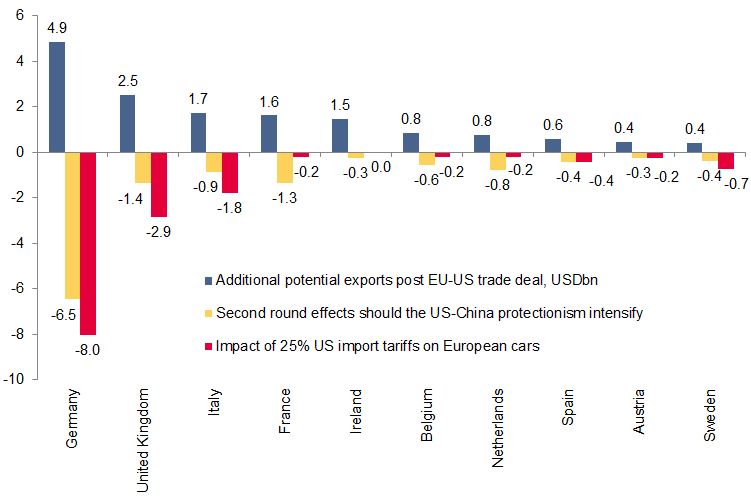Sources: Chelem, World Bank, Allianz Research
Fiscal stimulus to the rescue in France… and Germany!
Fiscal policy will become supportive in both France and Germany in 2019, although for different reasons.
In Germany, the degree of expansion of fiscal policy will increase strongly in 2019. The budgetary impact of the fiscal policy measures will be more than EUR 22bn or 0.6% of GDP (after EUR 8.2bn or 0.2% of GDP in 2018). Public expenditure is set to rise significantly by about +4.5% (2018: about +3%). This is mainly due to pension policy measures, as well as investment measures and additional expenditure in the area of development aid. Changes to the so-called maternal pension (Muetterrente II) alone account for EUR 3.8bn in additional spending in 2019. With employment and wages continuing to rise, income from taxes and social security contributions will continue to increase in 2019 as well. However, lower economic growth momentum and policy measures such as the increase in child allowances and basic allowances (EUR 1.3bn in total) will have a dampening effect. Overall, revenue growth in 2019 will be considerably below last year’s outcome (< +3%, after more than 4% in 2018). Thus, the fiscal surplus is expected to decline considerably from +1.7% of GDP in 2018 to about +0.8% this year.
In France, the situation is different. The government announced a EUR 10bn policy package (mainly through higher public subsidies for lower-income wages) that will likely push the fiscal balance to -3.2% of GDP in 2019 (-2.7% in 2018), off-track compared to EU constraints. In our view, these measures are not shifting French government priorities. It shows a willingness to answer to the strikes in order to end the protests and then reignite the calendar of reforms, with the next topics being unemployment benefits and the pension reforms. However, this still means that the calendar of reforms will probably be lengthened. Fiscal spending (56% of GDP in 2018) will stay high for longer. This will not pave the way for stronger tax cuts (total corporate tax and contributions represent 62% of profits), considering that the tax on corporate value added are among the highest in Europe (about 3%).
2019: Fighting for +1% growth
In France, we expect growth normalization from Q2 onwards (about +0.4% growth per quarter), based on lower inflation (+1.2% on average in 2019, compared to +1.8% in 2018) and voted tax cuts. Consumer spending will recover. However, the fiscal multiplier should be lower than expected since households turned more pessimistic about their financial situation (in 2018). Overall, this would put consumption growth at +1% in 2019, quite the same low growth as in 2018 despite better purchasing-power growth (+1.9% in 2019, compared to +1.1% in 2018). The likelihood that the government will revert to its reform agenda sooner or later will also trigger a short-run negative impact on household sentiment since pension reform is on its A-List. As a result, consumption will likely lag again in 2020 (+1.3% expected growth, compared to +1.5% GDP growth), putting even more pressure on consumer-related sectors’ payment behavior.
Figure 6: France, consumption growth vs. GDP growth











